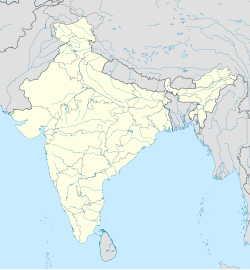Achabal
Achabal
Achival | |
|---|---|
 Achabal Town | |
| Coordinates: 33°41′N 75°14′E / 33.68°N 75.23°E | |
| Country | Jammu & Kashmir |
| Union territory | Jammu and Kashmir |
| District | Anantnag |
| Elevation | 1,936 m (6,352 ft) |
| Population (2001) | |
| • Total | 5,835 |
| Languages | |
| • Official | Kashmiri, Urdu, Hindi, Dogri, English[1][2] |
| Time zone | UTC+5:30 (IST) |
| Vehicle registration | JK03 |
Achabal (Urdu pronunciation: [ətʃʰəbəl]), known as Achival[3] (Kashmiri pronunciation: [at͡ʃʰiwal]) in Kashmiri, is a town in Anantnag district, in the union territory of Jammu and Kashmir, India.
Achabal is an important tourist town about 8.1 km away from Anantnag, and is notable for an ancient spring surrounded by a garden terraced and developed by the Mughals. The upper portion of the garden is called 'Bag-e-Begum Abad' developed by Malika Noor Jehan Begum in 1616 AD and renowned as Sahib Abad in which there is a Hamam (treasure of water) getting heat from a logical lamp (Tosnag).[citation needed]
Cascades and fountains have been erected by Mughal Emperors. A mosque standing in the garden is believed to have been constructed by Mughal Prince Dara Shikwah. Achabal was once the pleasure retreat of Empress Noor Jehan. A trout hatchery is also located nearby. Achabal is the site of a Mughal garden called Achabal Gardens.[citation needed]
Geography
[edit]Achabal is located at 33°41′N 75°14′E / 33.68°N 75.23°E.[4] It has an average elevation of 1936 metres (6352 feet) above mean sea level.[citation needed]
History
[edit]According to Kalhana's Rajatarangini Achabal(Sanskrit Akṣavāla) was founded by Akṣa son of King Nara II of Gonandiya dynasty.[5][better source needed]
Demographics
[edit]At the 2001 India census, Achabal had a population of 5835. Males constituted 53% of the population and females 47%. Achabal had an average literacy rate of 65%, higher than the national average of 59.5%; with 65% of the males and 35% of females literate. 12% of the population was under 6 years of age.[6]
Nearest tehsils
[edit]References
[edit]- ^ "The Jammu and Kashmir Official Languages Act, 2020" (PDF). The Gazette of India. 27 September 2020. Retrieved 27 September 2020.
- ^ "Parliament passes JK Official Languages Bill, 2020". Rising Kashmir. 23 September 2020. Archived from the original on 24 September 2020. Retrieved 23 September 2020.
- ^ Kashir Encyclopedia (in Kashmiri). Vol. 1. Jammu and Kashmir Academy of Arts Culture and Languages. 1986. p. 19.
- ^ Falling Rain Genomics, Inc - Achabal
- ^ M.A.Stein Kalhana's Rajatarangini: A Chronicle of the Kings of Kashmir Volume I Page 50 Published by Motilal Banarsidass Reprinted 1979.
- ^ "Census of India 2001: Data from the 2001 Census, including cities, villages and towns (Provisional)". Census Commission of India. Archived from the original on 16 June 2004. Retrieved 1 November 2008.


